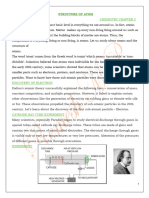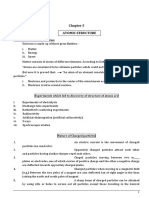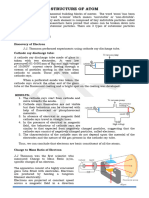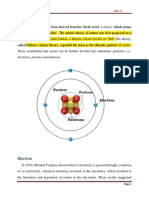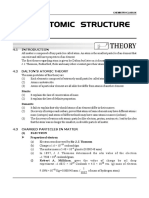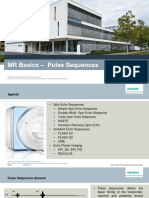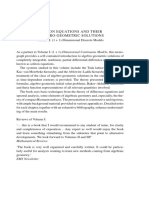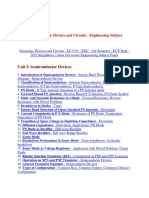Unit 1A Theory Book (Atomic Structure Note) - EM 2 - 240520 - 213517
Unit 1A Theory Book (Atomic Structure Note) - EM 2 - 240520 - 213517
Uploaded by
kavindya siriwardanaCopyright:
Available Formats
Unit 1A Theory Book (Atomic Structure Note) - EM 2 - 240520 - 213517
Unit 1A Theory Book (Atomic Structure Note) - EM 2 - 240520 - 213517
Uploaded by
kavindya siriwardanaOriginal Title
Copyright
Available Formats
Share this document
Did you find this document useful?
Is this content inappropriate?
Copyright:
Available Formats
Unit 1A Theory Book (Atomic Structure Note) - EM 2 - 240520 - 213517
Unit 1A Theory Book (Atomic Structure Note) - EM 2 - 240520 - 213517
Uploaded by
kavindya siriwardanaCopyright:
Available Formats
Unit 1 – TB 1
C H E M I S T R Y
Unit 01A|Theory Book
Atomic structure
Chemistry is the study of the properties and beahviour of matter. Matter, is the physical substance in which
the universe is made up of. Any substance that occupies mass and space is termed as matter. In here the
discussion is about the atom, which was believed by some scientists back then as the simplest form of
matter.
Definition of atom
Smallest particle which involves in a chemical reaction.
or
simplest form in which an element can exist.
or
simplest and neutral particle in which matter can be divided into.
Current idea about the atom
Consist of sub atomic particles like electrons, protons, neutrons, mesons, positrons.
Apart from electrons, other sub atomic particles (mainly protons and neutrons) are known as
“nucleons”.
Except electrons, other sub atomic particles called nucleons form a (+) charged area known as the
“Nucleus”.
Electrons revolve around “energy levels” (shells) which are located around the nucleus.
Atomic radius is about 10-10 m while the radius of the nucleus is about 10-15 m - 10-14 m. That
means the atom is 10,000 – 100,000 times larger than the nucleus.
Modern atomic theory A live prototype which depicts the atom can
be studied by scanning the following QR
code.
wñ, oikdhl | wdidfjka bf.k.kak 1
Sub atomic particles
Electron Proton Neutron
Symbol e p n
Charge
(𝐜 − coulomb)
Relative charge
Mass (𝐤𝐠) 9.107 x 10−31 kg 1.6725 x 10−27 kg 1.674 x 10−27 kg
Mass relative to proton
Discovery
History about the atom and its composition
1) Empedocles – believed that everything was made out from the four elements fire, water, air and sand.
2) Democritus – explained that materialistic world was made up from very small, invisible, indivisible
particles and used the word ‘atomos’ (atoms) for that which meant ‘indivisible’ or ‘unbreakable’. (Later,
Plato and Aristotle denied this concept. But from Dalton’s atomic theory it bounced back again.)
3) A definite explanation about the atom which we called as the indivisible building unit of matter was put
forward by an English scientist and a school teacher known as John Dalton (1766 – 1844) in 1808. Dalton’s
theory was based on four main facts.
1. Elements are made up from ‘atoms’ which are extremely small particle that cannot be divided
further.
2. All atoms of an element are similar in mass and size while atoms of different elements are different
to each other.
3. Atom of one element cannot be converted to an atom of another element by means of a chemical
reaction. That is during a chemical reaction, atoms can neither be created nor be destroyed.
4. Two or more atoms of different elements combine together in simple numerical ratios to form
compounds.
Dalton’s atomic model is known as the ‘golf ball model’.
4) In 1891, Johnstone G. Stoney (1826 – 1911) gave the name ‘electron’ for the basic particle in electricity.
But no evidence was there to prove its existence.
5) Around mid-1880s’ scientists were studying about electrical discharges happening inside air sealed glass
chambers. Sir Willliam Crookes (1832 – 1919) who was a British physicist and a chemist, invented this
chamber which was named as the crooks tube or cathode ray tube.
wñ, oikdhl | wdidfjka bf.k.kak 2
In these experiments that were conducted by Crooks and his fellow scientists, invisible band of rays were
observed to produce from the positively charged heated electrode or cathode when a very large potential
difference was applied across the two terminals of cathode ray tube. Even though, these rays were invisible
to the naked eye, these rays were capable of illuminating under low pressures and their existence was
revealed by its ability to produce a fluorescence when incident upon certain substances. These rays that
were emitted from the cathode were termed as ‘cathode rays. Later, it was discovered that these rays got
deflected when exposed to a magnetic field and thus were deduced to be negatively charged. Certain
scientists believed that these were waves while others were inclined towards a particulate behavior.
6) Furthermore, British scientist J.J. Thompson (1856 – 1940) was able to observe that the nature of these
rays possessed the same nature irrespective of the type of material that the cathode is composed of
and the type of gas present within the tube. Accordingly, he described cathode rays as a particle current
in 1897. Thereafter, he was able to calculate the ratio between the charge and the mass of an electron
𝑒
( ratio) using experimental results based on a cathode ray tube with a hole in the middle of the anode,
𝑚
and the result thus obtained was 1.76 x 108 C g-1 ^Coulombs per gram)'
- experiment calculating the e⁄m of electron.
Cathode ray experiment
Air
Cathode rays
Cathode Anode
⊝ ⊕
Crookes tube /
Cathode ray tube
12000V
When a large voltage is supplied and pressure is decreased by removing some amount of air inside cathode
ray tube, an invisible type of ray is observed to be formed from cathode and travelled towards the anode.
When this ray was collided with some sort of surface, a colour (mostly green) was emitted. As the rays were
emitted from cathode, they were termed as cathode rays by Crookes. Further experiments on cathode rays
were conducted by J.J. Thompson.
wñ, oikdhl | wdidfjka bf.k.kak 3
Properties of cathode rays
1) Negatively charged'
a) Deflected towards the positive terminal in an electrical field'
b) In a magnetic field, it is deflected perpendicular to the field, in the direction that a negatively
charged particle is deflected'
2) Particulate (possess a momentum and the ability to do work)
3) Moves from the cathode to the anode in a straight path'
4) Produced perpendicular to the surface of the cathode'
5) Possesses a constant charge/mass (e/m) ratio'
6) Has the ability to penetrate a thin metal sheet.
7) Collide upon metals with high mass numbers and produce X rays.
(discovery of X rays – Roentgen)
A detailed note will be given in the class.
How electron was revealed based on above observations
Identified that cathode rays possessed the same nature irrespective of the type of material that
the cathode is composed of and the type of gas present within the tube.
That is a (−) charged particle which is common in matter is present and Thompson concluded
that it is the particle that Stoney previously named as electron.
Charge of that particle wad determined by Robert A. Millikan by the oil drop test.
After the discovery of electron as mentioned above, Thompson put forward the plum pudding method to
describe the arrangement of electrons inside the atom.
Thompson model (Plum pudding model)
After the discovery of electron, golf ball model was not sufficient to explain the atomic structure. As per a
solution, J.J. Thompson introduced the plum pudding model. According to this model, nucleus is a (+)
charged solid sphere and (−) charged electrons are embedded throughout the nucleus. This is
corresponding to a pudding embedded with plums.
⊝ ⊝
+ (−) charged
⊝
(+) charged ⊝ + electrons
+
+ ⊝
solid sphere + ⊝
⊝
⊝ +
wñ, oikdhl | wdidfjka bf.k.kak 4
(+) rays / canal ray experiment
German Physicist Eugen Goldenstein was experimentally abled to prove the presence of positive particles
in matter. Here a discharge tube with a porous cathode and air under low pressure was used in this
experiment. When a high voltage about 10000 V was applied, a red colour fluorescence was observed
behind the porous cathode.
When a higher voltage is applied, the electrical field accelerates the small number of ions that are present
in the air. As these ions collide with the gas molecules, they get ionized removing electrons resulting the
formation of even more cations. These cations and electrons further collide with other gas molecules
resulting in an increment in the number of cations. These cations, thus formed are attracted towards the
negative cathode while some of those cations pass through pores.
Since these rays passed through the pores in the cathode, Goldstein named these rays as ‘canal rays. Since
these rays were not produced by the anode or from the positive electrode but were produced close to the
anode these rays were termed as ‘positive rays’ or ‘anode rays.
Properties of ^+& rays
1) Positively (+) charged'
a) Deflects towards the negative terminal in an electric field'
b) Deflects perpendicular to a magnetic field and in the direction that a positive particle deflects'
2) Particulate (possesses a momentum and the abillity to do work')
3) Moves in a linear path towards the cathode' ^Do not originate from the anode'&
4) e⁄m ratio of positive rays varies according to the gas used. When H2 gas is used, rays with the
lowest mass and highest e⁄m ratio is obtained. Other positive particles are multiples of the mass
of this lightest positive particle. So this should be a sub atomic particle.
The (+) rays that are obtained when H2 is used, possess a type of (+) particles that is common in matter. This
particle was termed as the proton by Rutherford.
Write the reactions that can occur inside a cathode ray tube filled with 𝐇𝟐 gas.
wñ, oikdhl | wdidfjka bf.k.kak 5
Radioactivity
The discovery of radioactivity by the French scientist Henry Becquerel (1852-1908) in 1896 was followed
by the discovery emission of three types of radiations by radioactive materials, namely alpha ^α&" beta ^β&
and gamma ^γ& by British Physicist Ernest Rutherford (1871-1973). The characteristic features of each
of those rays are tabulated as follows.
Radiation Alpha (𝜶) Beta (𝜷) Gamma (𝜸)
Composition Equal to a He nucleus Equal to an electron' Electromagnetic waves
Mass number 2 0 0
Charge +2 -1 0
Degree of penetration ③ ② ①
Ionization power ① ② ③
Speed ③ ② ①
Gold Leaf experiment of Geiger and Marsden and discovery of nucleus
Thin gold leaf
ZnS / applied screen
𝛼 rays
1 1
20000 8000
The alpha ray experiment was conducted under the leadership of Rutherford with the assistance of
Johannes Hans Wilhelm Geiger and Ernest Marsden in order to deduce the structure of the atom. There
they were able to observe that a majority of the rays or particles were able to penetrate the thin gold leaf
with minimal or no deflection. Furthermore, they observed that a number of particles refracted with
considerably large angles upon incidence on the leaf while a minimum reflected back upon incidence.
Accordingly, Rutherford expressed a new model for the atom based on the deductions, that major space
of an atom is empty and all positive charges of an atom is confined to a small charged space which
is called as the nucleus.
wñ, oikdhl | wdidfjka bf.k.kak 6
Based on further studies, Neils Bohr compacted the ideas that prevailed at that era and came to a conclusion
that the electrons orbit around the nucleus of an atom in a manner similar to the revolution of planets
around the sun. This is the first nuclear model about atom.
Furthermore, he stated that for electrons to specifically exist in atomic orbitals, the electrostatic forces that
exist between the nucleus and the electrons must be equal to the centrifugal force that is exerted on that
specific electron. In other words, electrons orbit the nucleus at a constant speed while maintaining a
constant distance from the nucleus.
This atomic structure that was expressed by Bohr was later termed as the Rutherford-Bohr
structure or the Bohr structure.
The non-continuous nature of matter is,
---------------------------------------------------------------------------------------------------------------------------------------
-------------------------------------------------------------------------------------------------------------------------
Drawbacks of planetary model.
1. No explanation about how all the protons in an atom stay together without any repulsion.
2. No explanation about how electrons orbiting the nucleus do not get attracted towards the nucleus.
Discovery of neutrons
James Chadwick discovered the neutron based on the experimental evidence that revealed the mass of the
atom to be greater than the aggregate of the masses of the protons and the electrons.
When the metal Be is collided with 𝛼 rays, neutral particles or rays are produced. Those are termed as
neutrons'
4Be + 2α + 10n
9 4 12
6C
Be sheet
𝛼 rays neutrons
wñ, oikdhl | wdidfjka bf.k.kak 7
Isotopes
The mass spectrometer that was discovered by the British scientists J.J. Thompson and Francis William
Astom (1877-1945) were used during the period of 1912-1913 in order to find the isotopes of Neon'
----------------------------------------------------------------------------------------------------------------------------- ----------
------------------------------------------------------------------------------------------------------------------------- --------------
The isotopes of the same element,
Possess similar chemical properties – as the number of electrons are equal.
Possess different physical properties – as the molecular masses are different (the number of
neutrons).
Example –
Hydrogen has three isotopes.
1
1H − Protium 2
1H − Deuterium 3
1H − Tritium
Oxygen has three isotopes.
16 17 18
8O 8O 8O
Mass Spectrometry
The mass spectrum of a hypothetical element is presented as follows'
Relative abundance %
^%&
50
40
10
Atomic mass
20 21 22 ^amu&
In the above element,
(20 x 50) + (21 x 40) +(22 x10)
Median Atomic Mass = = 20.6
100
wñ, oikdhl | wdidfjka bf.k.kak 8
Electromagnetic Waves
Electromagnetic waves are,
--------------------------------------------------------------------------------------------------------------------------------
--------------------------------------------------------------------------------------------------------------------------------
--------------------------------------------------------------------------------------------------------------------------------
Features of waves
i. Wavelength (𝜆)
--------------------------------------------------------------------------------------------------------------------------------
--------------------------------------------------------------------------------------------------------------------------------
ii. Frequency (𝑓)
--------------------------------------------------------------------------------------------------------------------------------
iii. Speed (𝑉)
iv. Wave Energy (𝐸)
According to the photon theory, that is used to describe certain qualities of waves, electromagnetic
waves transmit energy in the form of energy packets termed as ‘Photons’ (Quanta). Thus they are
incapable of exchanging energy continuously and thus exchange discreetly in the form of whole
number multiples of energy of one photon.
For a single photon in a wave,
wñ, oikdhl | wdidfjka bf.k.kak 9
Electromagnetic Spectrum
The spectrum obtained when the electromagnetic waves are arranged in the ascending order of their
frequencies is termed as the Electromagnetic Spectrum.
Absorption and Emission Spectra of H
Here, conditions are supplied to allow H atoms to absorb and emit energy and the spectra thus obtained
are analyzed.
Emission spectrum of H
+
Dark Background
𝜆↓
Spectrometer
^red& 𝐻𝛼 ^Green&𝐻𝛽 𝐻𝛾 ^Purple&
− The gas bulb containing
low pressure H2(g) Bright lines
Absorption spectrum of H
Bulb filled Bright
with H2(g) background
𝜆 decreases
White Spectrometer
light
Dark Lines
Important observations acquired:
The absorption and emissions spectra coincides 100%
Discreet spectra'
Lines converge towards the direction of increment of energy
Conclusion: Atoms are capable of emission and absorption of energy. However this occurs only in
the form of specific discreet quantities'
wñ, oikdhl | wdidfjka bf.k.kak 10
The Rutherford Bohr model was presented in order to explain the above observations. According to the
Bohr theory, the spectrum lines observed in a H atomic spectrum can be expressed in an energy level
diagram as follows.
E7
E6
Fund series
E5
Brackett series
E4
Paschen series
C1 E3
C4
Balmer series
E2
B1 B5
Lyman series
E1
A1 A6
The electron transmissions occurring at above energy levels can be expressed in a spectrum as follows.
Energy ↑
C4 C1 B5 B1 A6 A1
Paschen Balmer series Lyman series
series (I.R.) (Visible) (U.V.)
When the H2 emission spectrum is fractionated further, presence of a collection of lines placed in close
proximity to each other forming a single line can be observed. This is termed as the Siemen Effect.
Conclusion : Each energy level has sub energy levels and they are energy fractions of the energy of
the main energy level
Energy Quantization
In 1900 German Physicist Max Planck (1958-1947) stated that energy is quantized. Accordingly, electrons
in an atom absorb and emit energy in the form of discreet quantities, i.e. a whole number multiple of the
energy of a photon/quantum (energy packet) (𝑒 = ℎ𝑓).
wñ, oikdhl | wdidfjka bf.k.kak 11
The Wave-Particle Duality of an Electron
Even though electrons were concluded as particles, it was proved by the dual slit experiment that electrons
show wave properties in some instances. Up to now, no exact explanation about this scenario is present.
Most acceptable hypothesis about this is as follows.
When electrons are not under observation, they exist in a state called as ‘Super Position’ where electrons
show both particle and wave properties. But when they are under observation, they switch the state to
either particle or wave nature so we can observe it. Likewise electrons can show both particle and wave
properties but only one property can be observed per once.
This explanation is applicable for any matter even though it has presented for electrons.
Particulate Properties of Electrons
An electron beam has the ability to do work thus possesses a momentum. It also possesses a charge.
Wave properties of Electrons
Electron beams undergo refraction upon passage through narrow openings. (Just as when a beam of X-
rays is passed through an ionic lattice) Electrons also display diffraction patterns.
The De Broglie Equation
This equation can be used to calculate the wavelength of an electron or any matter when it exhibits wave
like behaviours.
h
λd = h − Planck’s constant
P
P − Momentum
h
λd =
mV
Atomic Orbitals
𝑒̅ exist in sub energy levels within “orbitals”. A maximum of two electrons can exist within one such orbital.
Orbitals can also be rephrased to be some form of energy packets. There are 4 sub-energy levels as s,p,d
and f. The number of orbitals within each of those sub-energy levels and the maximum number of electrons
that could be contained within them are tabulated as follows.
s.e.l No. of orbitals Max, number of 𝑒̅
s 1 2
p 3 6
d 5 10
f 7 14
wñ, oikdhl | wdidfjka bf.k.kak 12
The number of s.e.l that are present in each energy level and the total number of electrons that could be
housed within them are as follows'
E. level value No. of s.e.l. Max. number of 𝑒̅
1 s 2
2 s, p 8
3 s, p, d 18
4 s, p, d, f 32
5 s, p, d, f, 32
: :
Shapes of orbitals
The shape of an orbital can be termed as the maximum area that is permitted or allocated for the movement
of the electrons that are contained within them.
The shape of an orbital is obtained by integration of the equation provided by Erwin Schrödinger in the
description of the wave nature of electrons.
s orbitals – Spherical
p orbitals – Dumbbell shaped
s orbital
p orbitals
Quantum Numbers
Principal Quantum Number (𝒏) - Depicts the main energy level in which the electron exists.
n = 1 → First energy level
n = 2 → Second energy level
Angular Momentum Quantum Number (𝐥) - Depicts the sub energy level within the energy level in which
the electron is housed.
l = 0 → s Sub-energy level
l = 1 → p sub-energy level
l = 2 → d sub-energy level
wñ, oikdhl | wdidfjka bf.k.kak 13
Magnetic Quantum Number (𝐦/𝐦𝐥 ) - Depicts the orbitals of the sub-energy level in which the electrons
are contained.
s → → ml = 0
p →
-1 0 +1
d →
-2 -1 0 +1 +2
Spin Quantum Number (𝐬/𝐦𝐬 ) - Depicts the spin direction of the electron within the orbital.
1
↿ → ms = + 2
1
⇂ → ms = − 2
Relationship between n, l and ml
Pauli Exclusion Principle
"The quantum number set that is provided for an electron in an atom is unique to that electron."
or
"There are no two electrons in an atom which are totally identical to each other. "
or
"An orbital cannot possess more than two electrons."
wñ, oikdhl | wdidfjka bf.k.kak 14
Electronic configuration of an atom
When considering the electron structure of atoms, for a multi-electron atom of given n , the orbital energy
increases with the number. For example for orbitals of n = 3 , the energy increases in the order of 3s <
3p < 3d. The energies of all orbitals in a given sub shell (example the five orbitals in 3d) are equal.
Orbitals containing equal energies are termed as degenerate orbitals.
Building-up Principle (𝐀𝐮𝐟𝐛𝐚𝐮 𝐩𝐫𝐢𝐧𝐜𝐢𝐩𝐥𝐞)
The following diagram represents the order in which electrons are filled (in the ascending order of
energies) into energy levels.
1S2
2S2 2p6
3S2 3p6 3d10
4S2 4p6 4d10 4f14
5S2 5p6 5d10 5f14
6S2 6p6 6d10 6f14
7S2 7p6 7d10 7f 14
Deviation of the electronic configurations
Special types of deviations electronic configuration
44Ru - : 1s 2 2s2 2p6 3s2 3p6 3d10 4s 2 4p6 4d7 5s1
45Rb - : 1s 2 2s2 2p6 3s2 3p6 3d10 4s2 4p6 4d8 5s1
46Pb - : 1s 2 2s2 2p6 3s2 3p6 3d10 4s2 4p6 4d10 5s0
When writing the configurations of cations, the configuration of the atom is written and electrons are
removed from the last orbital.
When writing the configuration of anions, it is written according to the configuration of an atom containing
a number of electrons equal to the total number in the anion.
wñ, oikdhl | wdidfjka bf.k.kak 15
Hund’s Rule
"When electrons are filled into orbitals with same energy (orbitals in same sub energy level) it is
filled one per orbital until the number of unpaired electrons are maximum and then paired in a
manner such that their spin directions are opposite to each other"
Ex -: 2p1 ↿ 2p4 ↿⇂ ↿ ↿
2p2 ↿ ↿ 2p5 ↿⇂ ↿⇂ ↿
2p3 ↿ ↿ ↿ 2p6 ↿⇂ ↿⇂ ↿⇂
wñ, oikdhl | wdidfjka bf.k.kak 16
You might also like
- 2-Atomic BookletDocument91 pages2-Atomic BookletManashNo ratings yet
- ElasticityDocument70 pagesElasticityRiya gargNo ratings yet
- Chapter 1Document45 pagesChapter 1roaeray187No ratings yet
- CH 2 Structure of Atom 1Document109 pagesCH 2 Structure of Atom 1vhidulaaprakash18No ratings yet
- PPT Developed by NVS TeacherDocument114 pagesPPT Developed by NVS Teacherakhillakannan11No ratings yet
- IJSO Chemisty Atomic Structure PDFDocument49 pagesIJSO Chemisty Atomic Structure PDFriddhiNo ratings yet
- Atomic Structure: Synopsis - 1Document36 pagesAtomic Structure: Synopsis - 1Kovid AggarwalNo ratings yet
- Ch-2 Chemistry (Structure of Atom) Class-11Document10 pagesCh-2 Chemistry (Structure of Atom) Class-11kartikaryan9250No ratings yet
- 2.Structure of AtomDocument44 pages2.Structure of Atomyuvraj123ypnNo ratings yet
- Atomic StructureDocument36 pagesAtomic StructureRaveendra MungaraNo ratings yet
- Reviewer of Gen Chem 0 RWS 2ND Summative TestDocument8 pagesReviewer of Gen Chem 0 RWS 2ND Summative Test11boyle.locsinjanilleNo ratings yet
- CH - 2 Atomic StructureDocument25 pagesCH - 2 Atomic StructureYASH KUMARNo ratings yet
- Structure of Atom-TypedDocument25 pagesStructure of Atom-Typediringrace7No ratings yet
- Atomic StructureDocument109 pagesAtomic StructureBhaviya Pankaj keshvaniNo ratings yet
- Structure of AtomDocument18 pagesStructure of Atomfaisufaisal66666No ratings yet
- OP Tondon 2 Atomic StructureDocument83 pagesOP Tondon 2 Atomic StructureAbhishek Aryan0% (1)
- Review of Atomic Theory of Matter LectureDocument29 pagesReview of Atomic Theory of Matter LectureDerbew GahawNo ratings yet
- 2 Atomic StructureDocument109 pages2 Atomic Structuregnkstar50% (2)
- Atomic Structure Full Notes 50 PageDocument52 pagesAtomic Structure Full Notes 50 PageSubhajit GoraiNo ratings yet
- Atomic Structure VMC Study MaterialDocument52 pagesAtomic Structure VMC Study MaterialMameNo ratings yet
- Vidya Mandir Classes Class 11 ChemDocument812 pagesVidya Mandir Classes Class 11 ChemAtharvvaNo ratings yet
- Structure of AtomDocument106 pagesStructure of AtomJayesh ChouhanNo ratings yet
- The Structure of The AtomDocument28 pagesThe Structure of The AtomAnonymous dh6DITNo ratings yet
- (2087) Lecture Notes 1 Atomic Structure eDocument53 pages(2087) Lecture Notes 1 Atomic Structure eRamJiPandeyNo ratings yet
- Structure of Atom Chem 9thDocument6 pagesStructure of Atom Chem 9thPrashant ZadeNo ratings yet
- Atomic Structure PDFDocument40 pagesAtomic Structure PDFAnkit Maan100% (1)
- Ch-2 Chemistry Notes Part 1Document15 pagesCh-2 Chemistry Notes Part 1Ramandeep KaurNo ratings yet
- Document of Chapter 2Document17 pagesDocument of Chapter 2EstheruNo ratings yet
- Atomic Structure 5Document34 pagesAtomic Structure 5telepkNo ratings yet
- I Puc - Chemistry - Chapter 2 - Structure of Atom - FM - PRDocument20 pagesI Puc - Chemistry - Chapter 2 - Structure of Atom - FM - PRsrinivasrajesh2007No ratings yet
- Chemestry CollageDocument85 pagesChemestry CollageET039 Sudhabrata SahooNo ratings yet
- Chapter - 2 Structure of AtomDocument7 pagesChapter - 2 Structure of AtomViolet IrisNo ratings yet
- Atomic Structure-1Document28 pagesAtomic Structure-1Ahsan H SohagNo ratings yet
- Chemistry 9701 Complete Book For A LevelsDocument117 pagesChemistry 9701 Complete Book For A LevelsXamiyaNo ratings yet
- Chemistry Chapter 2Document30 pagesChemistry Chapter 2detective.vijay91No ratings yet
- Structure of Atom PDFDocument25 pagesStructure of Atom PDFNitika GrewalNo ratings yet
- Atomic Structure - Discovery of Subatomic ParticlesDocument6 pagesAtomic Structure - Discovery of Subatomic ParticlesDivyansh DangiNo ratings yet
- Engg - Chemistry (Diploma 1st2nd Sem)Document77 pagesEngg - Chemistry (Diploma 1st2nd Sem)deeppatel252007No ratings yet
- 2.STRUCTURE OF ATOMDocument45 pages2.STRUCTURE OF ATOMlalawmpuia2308No ratings yet
- 2.structure of Atom-Smart Booklet-1Document44 pages2.structure of Atom-Smart Booklet-1nadeemnagthan008No ratings yet
- Atomic Theory CH-1Document64 pagesAtomic Theory CH-1tazebNo ratings yet
- Atomic Structure Live Class-1 Teacher NotesDocument21 pagesAtomic Structure Live Class-1 Teacher NotesSHIVAM KUMAR SINGHNo ratings yet
- Structure of Atom NoteDocument9 pagesStructure of Atom NoteDeep palNo ratings yet
- Grade 11 Ch.2-Structure of AtomDocument20 pagesGrade 11 Ch.2-Structure of Atomkhushiyadav15092000No ratings yet
- Structure of AtomDocument107 pagesStructure of AtomDarshan Patil100% (1)
- Structure of AtomDocument10 pagesStructure of Atomالمونتاج الاخيرNo ratings yet
- Chapter 1 Atomic Structure UpdatedDocument75 pagesChapter 1 Atomic Structure Updatedqv85zkv4tzNo ratings yet
- 1.C-10-T1 - 01 ATOMIC STRUCTURE Pace FBDocument33 pages1.C-10-T1 - 01 ATOMIC STRUCTURE Pace FBriddhiNo ratings yet
- U-2StructureofAtom1 89626Document23 pagesU-2StructureofAtom1 89626Anirudh AshrithNo ratings yet
- U-2StructureofAtom1 89626Document23 pagesU-2StructureofAtom1 89626Anirudh AshrithNo ratings yet
- Structure of AtomDocument18 pagesStructure of Atomchetnasri01No ratings yet
- Atomic Structure: Md. Kaium HossainDocument25 pagesAtomic Structure: Md. Kaium Hossainmahikazad91No ratings yet
- Structure of AtomDocument29 pagesStructure of AtomAnisha AnnamalaNo ratings yet
- Atomic Structure ADocument36 pagesAtomic Structure AManju MathurNo ratings yet
- Structure of AtomDocument31 pagesStructure of Atomthinkiit100% (1)
- 02-Structure of AtomDocument100 pages02-Structure of Atomtorodoki15No ratings yet
- Hsslive in Xi Chem 2. Structure of AtomDocument14 pagesHsslive in Xi Chem 2. Structure of Atomgiridharviswanathan2008No ratings yet
- AIIMS-MBBS-2019-25 May-Morning PhysicsDocument172 pagesAIIMS-MBBS-2019-25 May-Morning PhysicsAsmitNo ratings yet
- 05 Basic Pulse SequencesDocument97 pages05 Basic Pulse SequencesAnukhatan DavaarentsenNo ratings yet
- KU 13 AntennaDocument30 pagesKU 13 Antennawexeta3713No ratings yet
- Lab Exercise 5Document1 pageLab Exercise 5JEREMY DAWN ZAMORA CABALLERONo ratings yet
- Chapter 10 Manufacturing EngineeringDocument17 pagesChapter 10 Manufacturing EngineeringKirana PitalokaNo ratings yet
- Class 12 Physics QBDocument263 pagesClass 12 Physics QBRohit KumarNo ratings yet
- Levido Round: 901594.002.1 - Recessed DownlightsDocument1 pageLevido Round: 901594.002.1 - Recessed DownlightsKaide Johar BohraNo ratings yet
- Remote Control TesterDocument2 pagesRemote Control TesterMuzammil WepukuluNo ratings yet
- CSE 313 Lecture 4 - ExamplesDocument22 pagesCSE 313 Lecture 4 - ExamplesKelvho Gitonga75% (4)
- 100 R77 DRS90M4 ProductData en DEDocument1 page100 R77 DRS90M4 ProductData en DEluis terronesNo ratings yet
- The Feasibility of ChiliDocument6 pagesThe Feasibility of ChiliChas SorianoNo ratings yet
- Newtons Laws of MotionDocument3 pagesNewtons Laws of MotionrachelgalachaNo ratings yet
- Technical Specification - MV Power CableDocument2 pagesTechnical Specification - MV Power CableVinicius TomazNo ratings yet
- Geosynthetic Institute: GRI Standard Practice GG4 (A)Document15 pagesGeosynthetic Institute: GRI Standard Practice GG4 (A)irsanNo ratings yet
- Phy ProjectDocument17 pagesPhy ProjectswarikadesaiNo ratings yet
- Durasin & Shockfast Comparsion EnglishDocument1 pageDurasin & Shockfast Comparsion Englishhassan hamdyNo ratings yet
- 11 - Isomerism in TMCDocument18 pages11 - Isomerism in TMCMohit KambojNo ratings yet
- Comparision Between HT-LT AVCDocument2 pagesComparision Between HT-LT AVCVyankatesh KulkarniNo ratings yet
- Immediate download An Introduction to Noncommutative Noetherian Rings 2nd Edition K. R. Goodearl ebooks 2024Document85 pagesImmediate download An Introduction to Noncommutative Noetherian Rings 2nd Edition K. R. Goodearl ebooks 2024nemrudkooren100% (2)
- PAROC Calculus: Calculation 1: Rectangular TankDocument2 pagesPAROC Calculus: Calculation 1: Rectangular Tankvipul gandhiNo ratings yet
- Soliton Equations and Their Algebro-Geometric SolutionsDocument448 pagesSoliton Equations and Their Algebro-Geometric Solutionsmohamed ragabNo ratings yet
- Engineering Mechanics TutorialsDocument4 pagesEngineering Mechanics Tutorials2B Dai Ko DUPLICATENo ratings yet
- Contactors ENTRELEC PDFDocument111 pagesContactors ENTRELEC PDFembasianNo ratings yet
- Mechanical Design For Sieve Plate ColumnDocument14 pagesMechanical Design For Sieve Plate ColumnIan Zuhair II100% (1)
- Electronic Devices and CircuitsDocument4 pagesElectronic Devices and CircuitsSudalai MadanNo ratings yet
- 2018 N5 Chemistry Past PaperDocument48 pages2018 N5 Chemistry Past PaperIslay JacksonNo ratings yet
- Steam Jet Air EjectorsDocument3 pagesSteam Jet Air EjectorsSherwin SabandoNo ratings yet
- 16 6 Solving Sss TrianglesDocument5 pages16 6 Solving Sss Trianglesapi-299265916No ratings yet
- 3M High Voltage - and - Grid Automation Growing - Our - Future - CEE February 2015 PresentationDocument138 pages3M High Voltage - and - Grid Automation Growing - Our - Future - CEE February 2015 PresentationmohammadkassarNo ratings yet
- Bind Us TogetherDocument391 pagesBind Us TogetherIsheanesu MarimbeNo ratings yet













